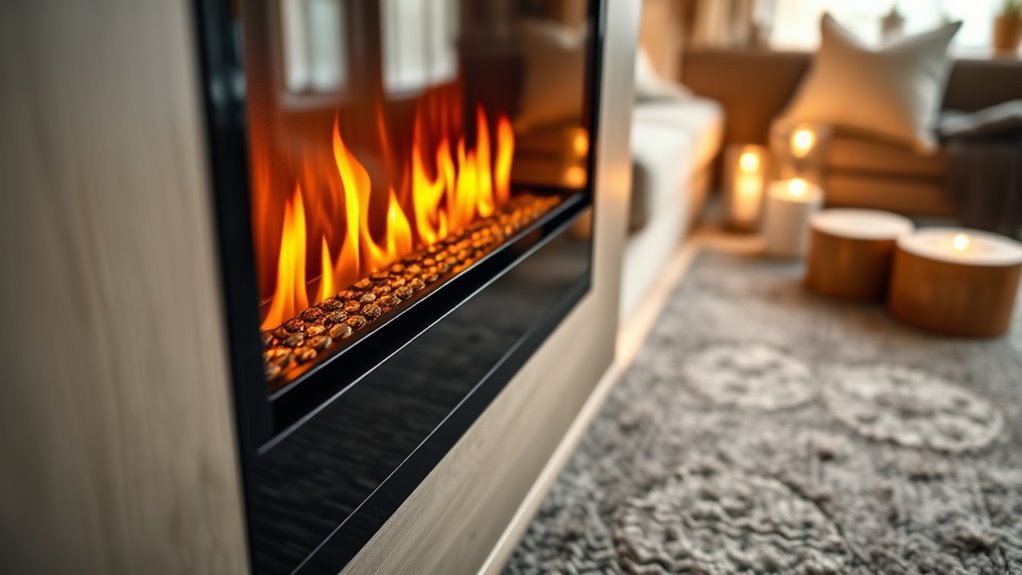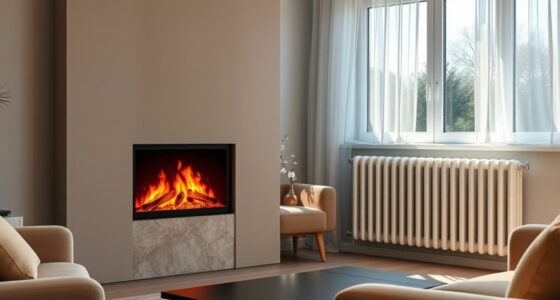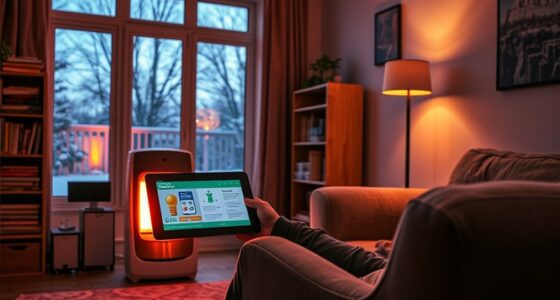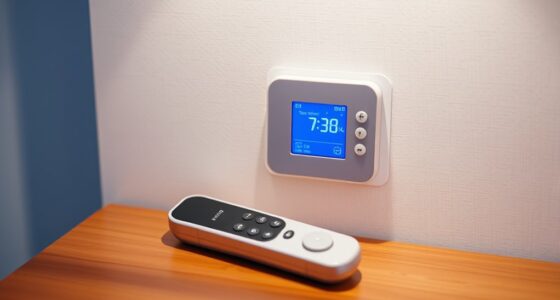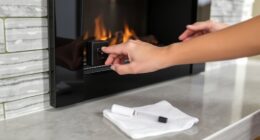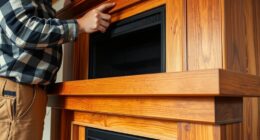Running an electric fireplace is usually affordable and depends on your electricity rates and how long you use it. Most models convert nearly all electricity into heat, so your costs stay predictable. On average, keeping it on for a few hours daily might only add a few dollars to your monthly bill. Using adjustable settings and timers helps save even more. To discover tips on minimizing expenses and making the most of your unit, keep exploring further.
Key Takeaways
- Electric fireplaces convert nearly all electricity into heat, making their operation cost-efficient compared to traditional fireplaces.
- Operating costs depend on electricity rates and usage duration; typical costs are relatively low.
- Using adjustable settings, timers, and thermostats optimizes energy consumption and reduces expenses.
- Maintenance is minimal, with low repair costs, mainly involving occasional bulb or filter replacements.
- Proper operation and safety measures enhance energy efficiency, keeping running costs predictable and affordable.
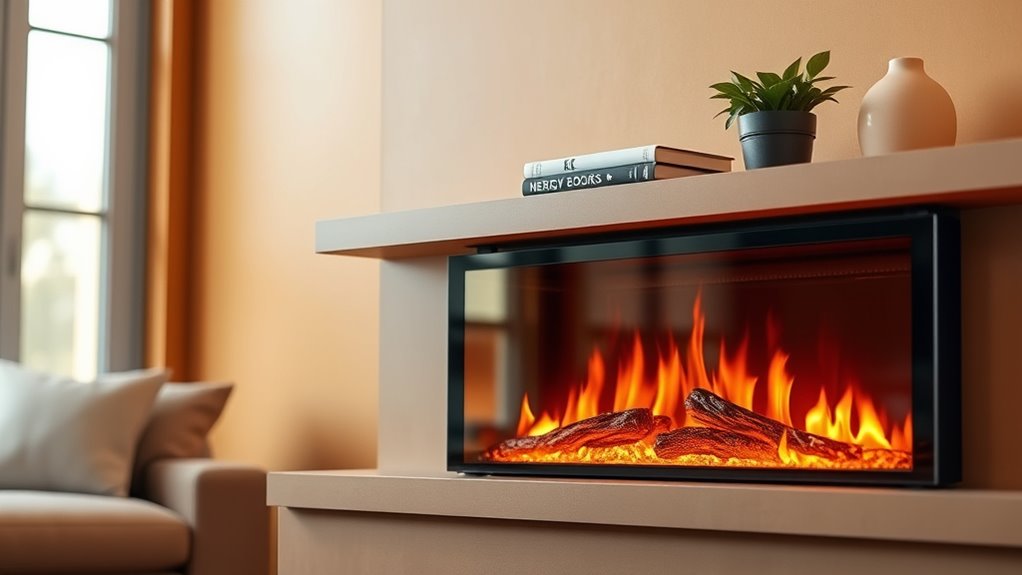
Have you ever wondered how much it really costs to run an electric fireplace? The answer depends on several factors, but understanding the basics can help you manage your energy bills effectively. One of the main advantages of electric fireplaces is their energy efficiency. Unlike traditional wood or gas fireplaces, electric models convert almost all the electricity they consume into heat, meaning very little energy is wasted. This high efficiency ensures you get adequate warmth without using excessive power, helping to keep your running costs manageable. Since you’re only paying for the electricity used to operate the unit, your overall energy costs tend to be lower than with other heating options, especially if you use the fireplace to supplement your main heating system rather than replace it entirely.
However, it’s essential to consider how often and how long you run your electric fireplace. Running it continuously will naturally increase your energy bills, but even then, the costs remain relatively modest. Most modern electric fireplaces are designed to be energy-efficient, with adjustable settings that let you control heat output and ambiance without wasting power. If you set the thermostat correctly and use features like timers or remote controls, you can avoid unnecessary energy consumption. This level of control ensures your energy efficiency stays high, and your costs stay predictable.
When it comes to maintenance costs, electric fireplaces are quite economical. Unlike traditional fireplaces, they don’t require regular chimney cleaning, venting, or fuel purchases, which greatly reduces ongoing expenses. You mainly need to keep the unit clean and ensure the electrical components are in good condition. This typically involves occasional dusting, checking the power cord, and replacing any burnt-out bulbs or filters if your model has them. Because there are fewer moving parts and no combustion process, maintenance costs are minimal, and repairs are generally straightforward and inexpensive. Most issues can be addressed with simple troubleshooting or professional servicing if needed, which is usually less costly than maintaining a gas or wood-burning fireplace.
Additionally, incorporating ventilation considerations can further optimize energy use and safety.
Frequently Asked Questions
Do Electric Fireplaces Increase Overall Home Energy Bills?
Yes, electric fireplaces can increase your overall home energy bills, but their impact depends on factors like usage and energy efficiency. A proper cost comparison shows they are generally affordable to operate, especially since many models offer energy-efficient features. You can reduce costs by using thermostats and timers, ensuring you’re not wasting energy. Overall, electric fireplaces are a cost-effective way to add ambiance without markedly boosting your home’s energy expenses.
Are There Any Hidden Fees Associated With Electric Fireplace Operation?
You won’t encounter hidden fees when operating your electric fireplace, but it’s wise to contemplate maintenance costs. Regular cleaning or replacing parts like filters may add to your expenses over time. Keep an eye on warranties and service plans, as they can help reduce unexpected costs. Overall, electric fireplaces are budget-friendly, but staying aware of potential maintenance expenses ensures you won’t be caught off guard.
How Does Outdoor Temperature Affect Electric Fireplace Energy Use?
Outdoor temperature acts like a thermostat for your electric fireplace’s energy use. When it’s colder outside, your fireplace works harder, increasing energy consumption to keep your space warm. Conversely, on milder days, it runs less often and consumes less power. So, as outdoor temperatures drop, expect higher energy use, making it essential to adjust settings or use additional insulation to keep costs manageable while staying cozy.
Can Electric Fireplaces Be Used as Primary Heating Sources?
Yes, you can use electric fireplaces as primary heating sources, especially in smaller spaces. They offer good heating efficiency and are cost-effective compared to traditional options. When considering cost comparison, electric fireplaces usually consume less energy and are cheaper to operate. However, for larger areas or colder climates, supplemental heating might be necessary. Always assess your space size and insulation to determine if an electric fireplace can meet your primary heating needs.
What Safety Precautions Should I Take When Running an Electric Fireplace?
Picture a cozy glow filling your room, but safety always comes first. You should regularly inspect your electric fireplace for signs of damage, keep it away from flammable materials, and guarantee it’s plugged into a grounded outlet. Never overload circuits, and avoid using extension cords. Prioritizing fireplace safety helps prevent electrical hazards, so stay vigilant, follow manufacturer instructions, and enjoy the warmth without risking a fire or shock.
Conclusion
When you run your electric fireplace, think of it as lighting a candle—warm, inviting, and surprisingly affordable. I once watched a friend’s electric fireplace for a winter evening, and it cost less than a cup of coffee to keep her living room cozy all night. Just like that gentle flame, your electric fireplace offers comfort without burning through your budget, making it a smart, cost-effective way to enjoy the glow of warmth whenever you want.
